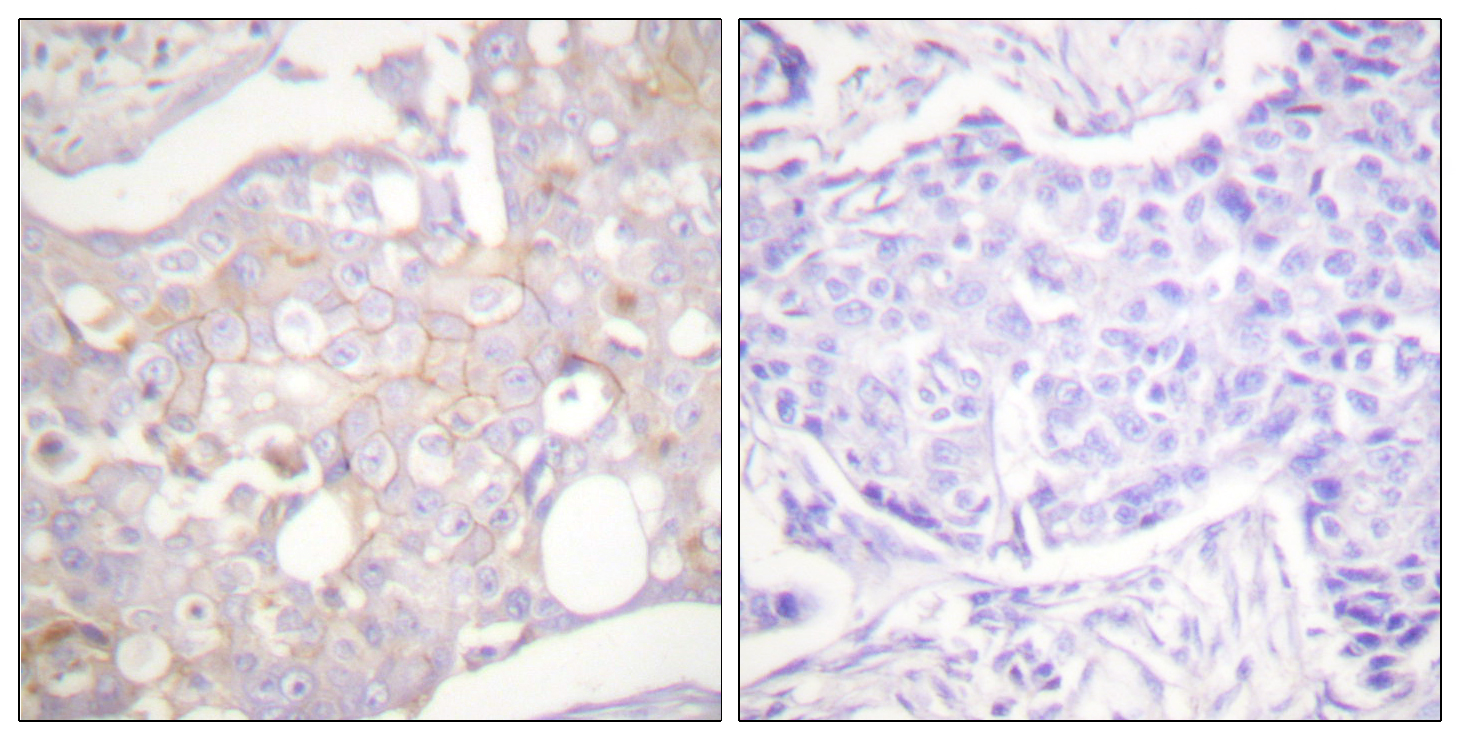Claudin-4 Polyclonal Antibody
- Catalog No.:YT0951
- Applications:WB;IHC;IF;ELISA
- Reactivity:Human;Mouse;Rat
- Target:
- Claudin-4
- Fields:
- >>Cell adhesion molecules;>>Tight junction;>>Leukocyte transendothelial migration;>>Pathogenic Escherichia coli infection;>>Hepatitis C
- Gene Name:
- CLDN4
- Protein Name:
- Claudin-4
- Human Gene Id:
- 1364
- Human Swiss Prot No:
- O14493
- Mouse Gene Id:
- 12740
- Mouse Swiss Prot No:
- O35054
- Immunogen:
- The antiserum was produced against synthesized peptide derived from human Claudin 4. AA range:160-209
- Specificity:
- Claudin-4 Polyclonal Antibody detects endogenous levels of Claudin-4 protein.
- Formulation:
- Liquid in PBS containing 50% glycerol, 0.5% BSA and 0.02% sodium azide.
- Source:
- Polyclonal, Rabbit,IgG
- Dilution:
- WB 1:500 - 1:2000. IHC 1:100 - 1:300. IF 1:200 - 1:1000. ELISA: 1:5000. Not yet tested in other applications.
- Purification:
- The antibody was affinity-purified from rabbit antiserum by affinity-chromatography using epitope-specific immunogen.
- Concentration:
- 1 mg/ml
- Storage Stability:
- -15°C to -25°C/1 year(Do not lower than -25°C)
- Other Name:
- CLDN4;CPER;CPETR1;WBSCR8;Claudin-4;Clostridium perfringens enterotoxin receptor;CPE-R;CPE-receptor;Williams-Beuren syndrome chromosomal region 8 protein
- Observed Band(KD):
- 22kD
- Background:
- The protein encoded by this intronless gene belongs to the claudin family. Claudins are integral membrane proteins that are components of the epithelial cell tight junctions, which regulate movement of solutes and ions through the paracellular space. This protein is a high-affinity receptor for Clostridium perfringens enterotoxin (CPE) and may play a role in internal organ development and function during pre- and postnatal life. This gene is deleted in Williams-Beuren syndrome, a neurodevelopmental disorder affecting multiple systems. [provided by RefSeq, Sep 2013],
- Function:
- disease:Haploinsufficiency of CLDN4 may be the cause of certain cardiovascular and musculo-skeletal abnormalities observed in Williams-Beuren syndrome (WBS), a rare developmental disorder. It is a contiguous gene deletion syndrome involving genes from chromosome band 7q11.23.,function:Plays a major role in tight junction-specific obliteration of the intercellular space.,similarity:Belongs to the claudin family.,subunit:Directly interacts with TJP1/ZO-1, TJP2/ZO-2 and TJP3/ZO-3.,
- Subcellular Location:
- Cell junction, tight junction . Cell membrane ; Multi-pass membrane protein . CLDN4 is required for tight junction localization in the kidney. .
- Expression:
- Colon,Fetal brain,Trachea,
Changes in intestinal barrier protein expression and intestinal flora in a rat model of visceral hypersensitivity. NEUROGASTROENTEROLOGY AND MOTILITY 2021 Nov 25 WB Rat 1:1000 Colon tissue
Changes in the Gut Microbiome Contribute to the Development of Behcet’s Disease via Adjuvant Effects. Frontiers in Cell and Developmental Biology Front Cell Dev Biol. 2021 Sep;0:2482 WB Mouse 1:1000 Colon
Fermented blueberry pomace ameliorates intestinal barrier function through the NF-κB-MLCK signaling pathway in high-fat diet mice. Food & Function Food Funct. 2020 Apr;11(4):3167-3179 WB Mouse 1:2000 ileal tissues
- June 19-2018
- WESTERN IMMUNOBLOTTING PROTOCOL
- June 19-2018
- IMMUNOHISTOCHEMISTRY-PARAFFIN PROTOCOL
- June 19-2018
- IMMUNOFLUORESCENCE PROTOCOL
- September 08-2020
- FLOW-CYTOMEYRT-PROTOCOL
- May 20-2022
- Cell-Based ELISA│解您多样本WB检测之困扰
- July 13-2018
- CELL-BASED-ELISA-PROTOCOL-FOR-ACETYL-PROTEIN
- July 13-2018
- CELL-BASED-ELISA-PROTOCOL-FOR-PHOSPHO-PROTEIN
- July 13-2018
- Antibody-FAQs
- Products Images

- Western Blot analysis of various cells using Claudin-4 Polyclonal Antibody diluted at 1:2000

- Immunohistochemistry analysis of paraffin-embedded human breast carcinoma tissue, using Claudin 4 Antibody. The picture on the right is blocked with the synthesized peptide.



